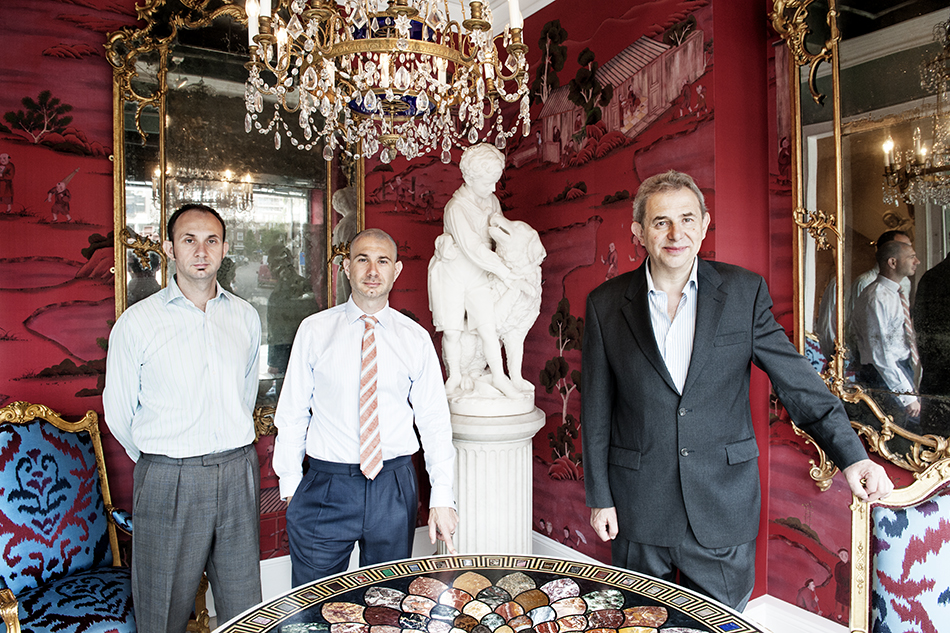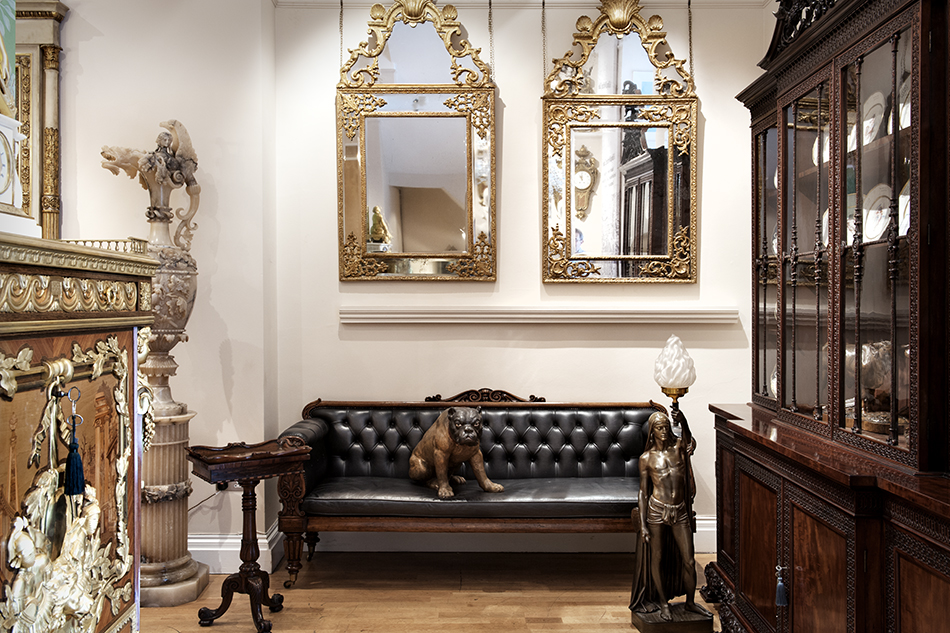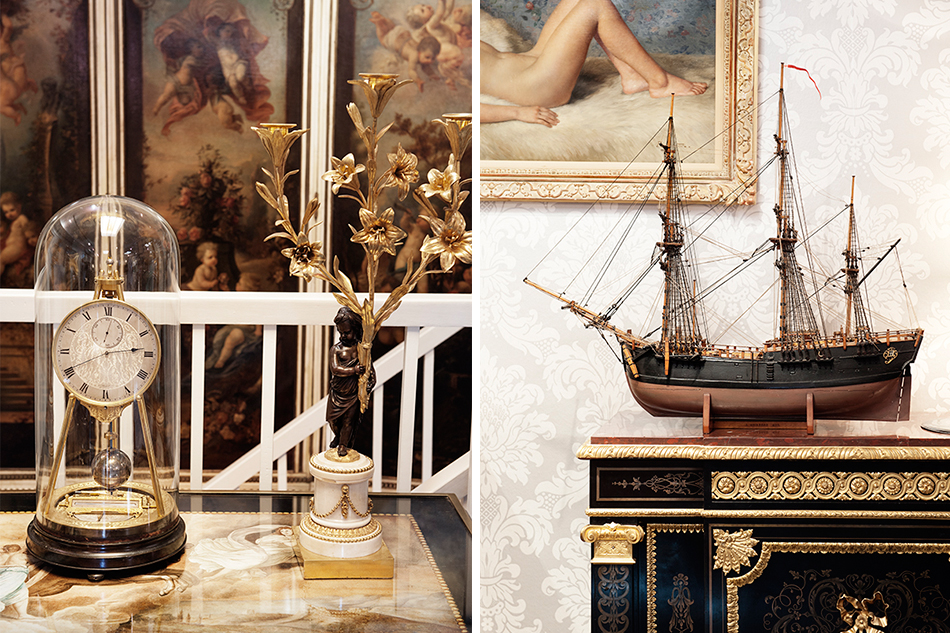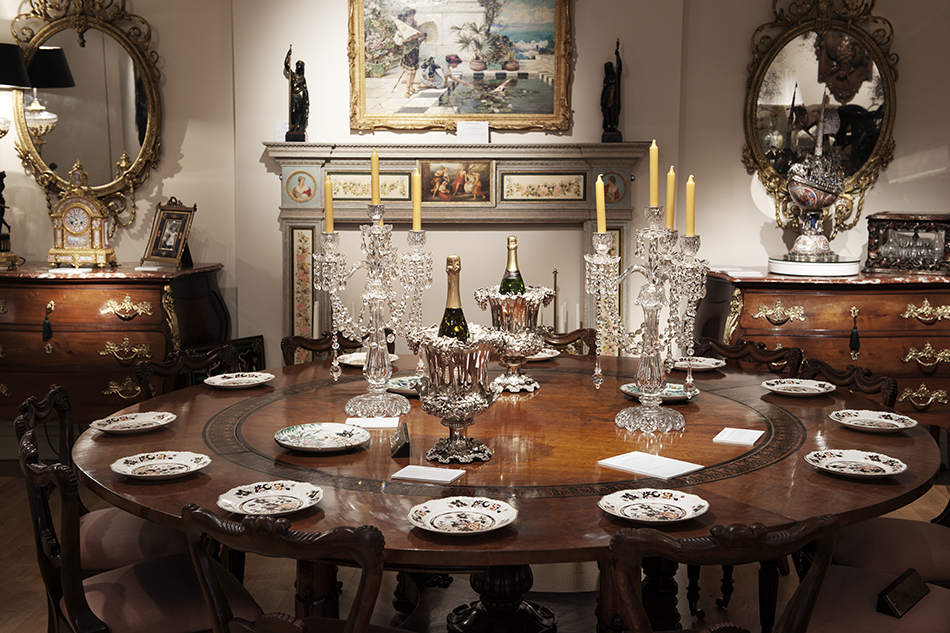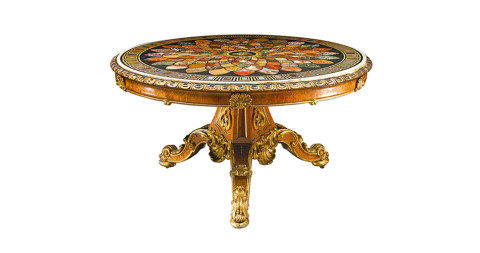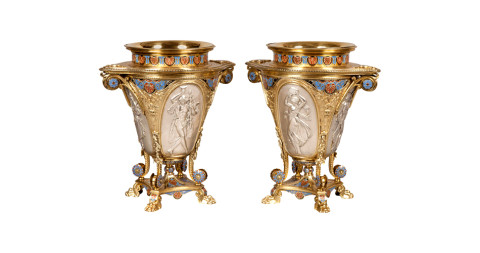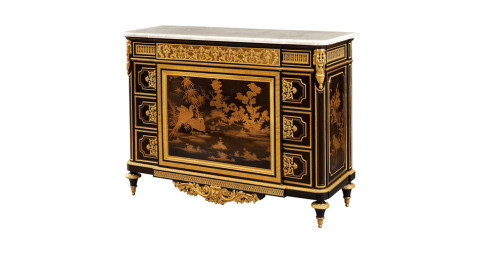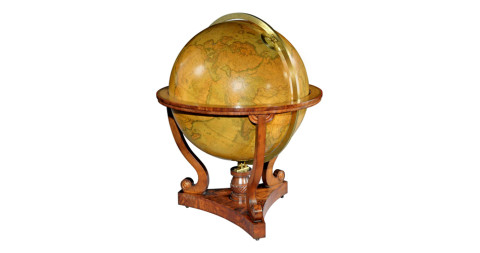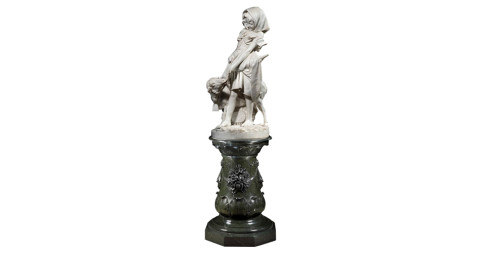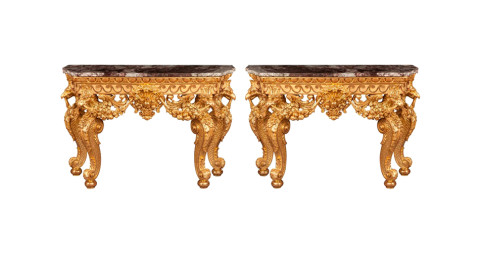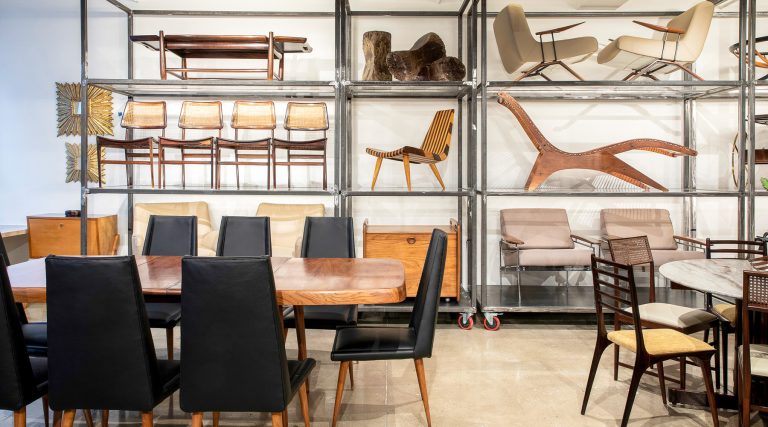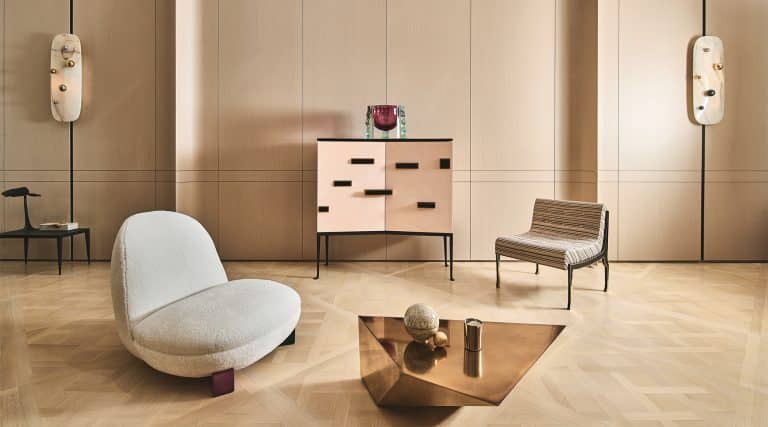
November 12, 2015Stunning 18th- and 19th-century pieces displayed at Butchoff Antiques, family-owned for three generations. Shown above are a chinoiserie longcase clock created by King George III clockmaker John Ellicott and an exhibition-quality Bonheur du Jour by Holland & Sons. Top: Louis XVI–style and hand-painted Sèvres clocks rest on a Henry Dasson side cabinet, 1884.
Come in! Put your umbrella down anywhere,” says Adam Kaye, welcoming me to Butchoff Antiques. Anywhere? Underneath a unique 1840s table inlaid with marble micro-mosaics? Close to a magnificent walnut dressing table made by George Betjemann (the great-grandfather of the poet John Betjeman), its pull-out drawers meticulously divided into compartments just the right size to hold perfectly preserved silver-top bottles and all manner of implements? Or should I leave it to drip on a Louis XIV–style giltwood sofa plushly upholstered in purple velvet?
Butchoff Antiques has a lot of good company on London’s Kensington Church Street, but the friendly and welcoming style of the proprietors, brothers Adam and James Kaye, together with its mouth-watering displays of 19th-century Georgian furniture and unusual decorative objects, have made the shop a magnet for collectors and lovers of all things rare and beautiful.
The brothers are the third generation involved with this family business. It was started by their grandfather, a silver dealer, and continued by their uncle, Ian Butchoff, who worked for his father from the age of 11 and oversees the company with Adam and James. Ian first opened a store in 1964, in the far less salubrious South London neighborhood of Elephant & Castle, moving to West London in the early 1980s and then to the shop’s current location 14 years ago. At first, he kept up the family tradition by dealing in silver, but he soon began to buy and sell bronzes, then paintings and furniture, eventually developing a specialization in Georgian pieces from the 1760s to the 1900s.
His nephews worked at the store during school holidays but initially pursued other careers: Adam was a fitness instructor; James worked in finance. Gradually, however, both found themselves drawn to the antiques trade. “It was never forced upon us, but I suppose it’s in your blood,” Adam says, laughing.

Butchoff is nestled on London’s Kensington Church Street, known for top-quality antiques.
They have upped Butchoff’s presence at international trade fairs (through November 24, they can be found at the New York Art, Antique and Jewelry Show at the Park Avenue Armory) and introduced Internet sales, including via their 1stdibs storefront. “Even on Christmas Day,” James says ruefully. “Whenever it is, we pride ourselves on getting back to people fast.”
Having found a place to stow their visitor’s umbrella, the brothers spoke to Introspective about the importance of personal taste, their love for decorative details and the rationale behind buying the best you can afford.
How did you develop a specialty in Georgian-style furniture?
James: Ian always bought quality pieces, and when he first started to buy furniture, most dealers were doing eighteenth-century stuff. So he stuck mainly to the nineteenth century. Taste comes into it too, of course. He — and we — have always liked a variety of woods and textures. Ian would buy satinwood, which people didn’t understand at the time, as well as ormolu, wood, marble. So we’ve always had a decorative side and been quite eclectic.
Adam: The nineteenth century is more flamboyant than the eighteenth century, decoratively speaking. We like Georgian and late Regency pieces, with their carving and ornamentation, and we have a large selection of really top nineteeth-century furniture makers, like Holland & Son, Wright and Mansfield, Dasson and Edwards & Roberts, who made very specific pieces for wealthy people or for exhibitions. A lot of people who don’t necessarily understand antiques, or the timber, can respond to and appreciate the decorative aspect and wonderful craft of that era.

Exceptional pieces at the shop include Italian alabaster vases; a cabinet designed by renowned 19th-century French furniture maker Henry Dasson; Elkington parcel-gilt-silver and enameled wine coolers that had been shown at the 1862 Great Exhibition in London; an Art Nouveau Daum acid-etched lamp; and Honduras mahogany fauteuils.
Where do you find your pieces?
Adam: We do a lot of house calls and have dealers who work for us all over the world. A lot is word of mouth, but it’s not uncommon to have people phoning up and saying they’ve got a clock or a candelabra that’s similar to something on our website. The Internet has made an enormous difference that way.
Have you had any memorable surprising discoveries?
James: Last year, we bought a secrétaire that was a late-nineteenth-century copy of a seventeenth-century piece in the Wallace Collection. Someone from the collection came to see it and couldn’t believe the quality of the copy. It ended up in an exhibition at the Wallace, where they put the two pieces side by side and took off some of the mounts and a door so that you could compare and contrast. What was fascinating was that several people, including the head conservator, said that the nineteenth-century copy was better made. It was a real honor and a proud moment for us.
Do your buyers tend to be private individuals? Other dealers? Local or foreign?
Adam: Mostly private individuals, although decorators do come to us, and we still deal with trade around the world. Each year has been different in terms of whom we sell to — there is a real mix of local and overseas buyers. We have a big international clientele that lives in London. But although we try to analyze the business, we’re not a sweet shop. For us, it has always been about buying things that are different, that speak to us, and we don’t try to predict the tastes, or changes in taste, of our customers.

The brothers encourage mixing different periods and styles. Shown are a Louis XVI–style gilt-bronze chandelier and the circa 1880 oil painting The Beautiful Bandurria Player by Raimundo de Madrazo y Garreta.
Can you talk about some of those changes in taste?
James: Yes, things go through phases. Fifteen years ago, you couldn’t sell ormolu furniture. Now it seems to be widely popular. That might be because we are seeing far more Russian and Middle Eastern buyers in London, and it appeals to that market because black and ormolu furniture fits easily into a modern context. Our Chinese and Russian customers are not very interested in the Georgian furniture, but there is still a strong market for it.
Adam: We’ve also noticed a lot of interest in decorative pieces. We’ve always had a bit, but we’ve started to buy more over the past ten years. Interestingly, clocks are very popular right now. Also people are less concerned about everything being in one period style: Not every piece of furniture has to be Georgian mahogany or whatever. We encourage that. We mix and match styles, periods, furniture and decorative pieces in our shop, and people are doing that much more in their homes.
What advice would you give to a novice antiques buyer?
James: Sometimes people come in who don’t know about antiques, but they home in on something that appeals to them, which is great. We never say, You should buy for investment. You should buy the best you can afford of what you like. As our grandfather used to say, “Cheap is expensive!” We put our own money into our things and want to educate people to buy good pieces. Don’t be intimidated by antiques. You don’t have to know a lot, but if you like a piece, try to find out as much as you can about when it was made, by whom and what its provenance is. We give as much information as possible in the shop, with brochures that have full descriptions and drawings of each piece. And we have a full library of many valuable books, which we often bring out and are happy for people to consult. It’s obvious, but the more you understand about what you buy, the more you will appreciate it.
TALKING POINTS
Adam and James Kaye share their thoughts on a few choice pieces.

